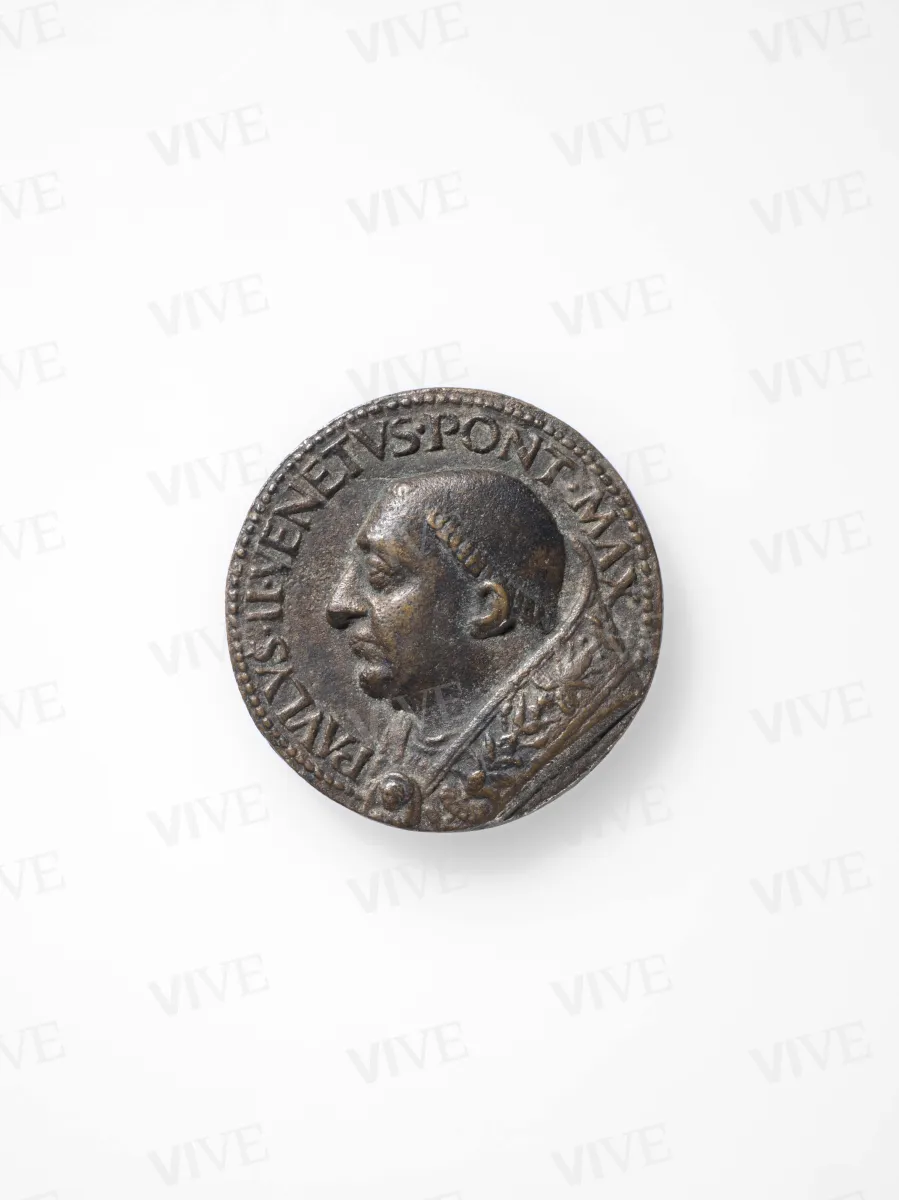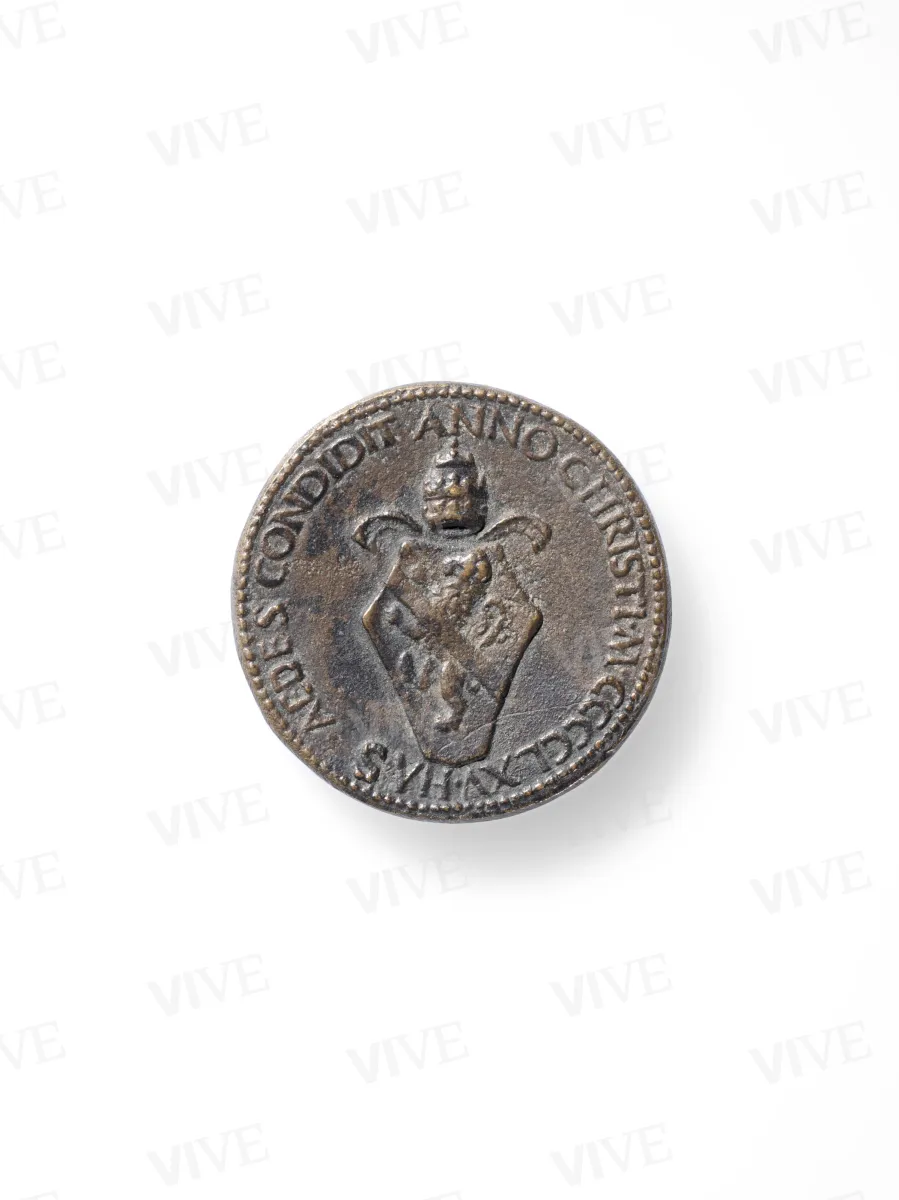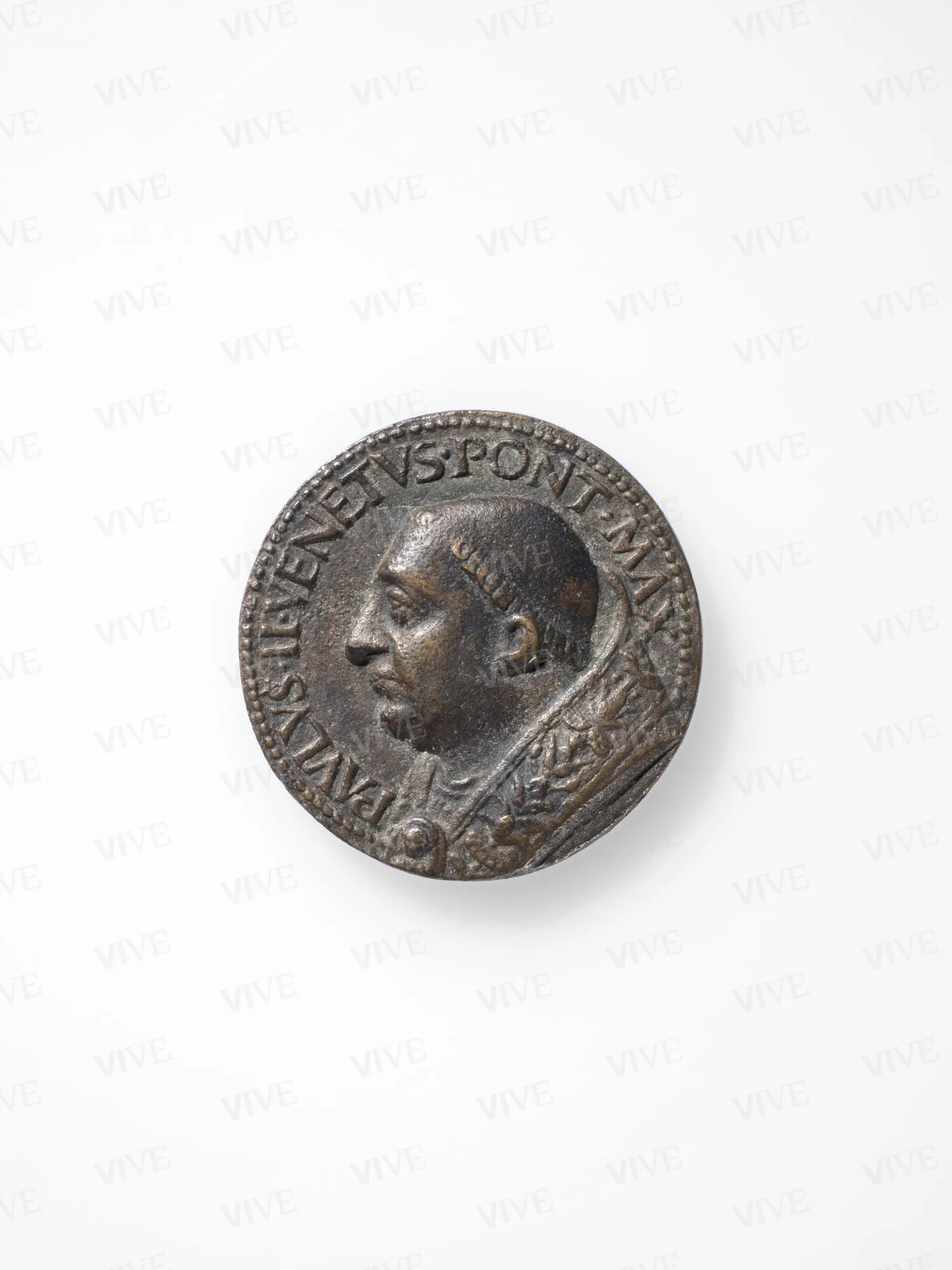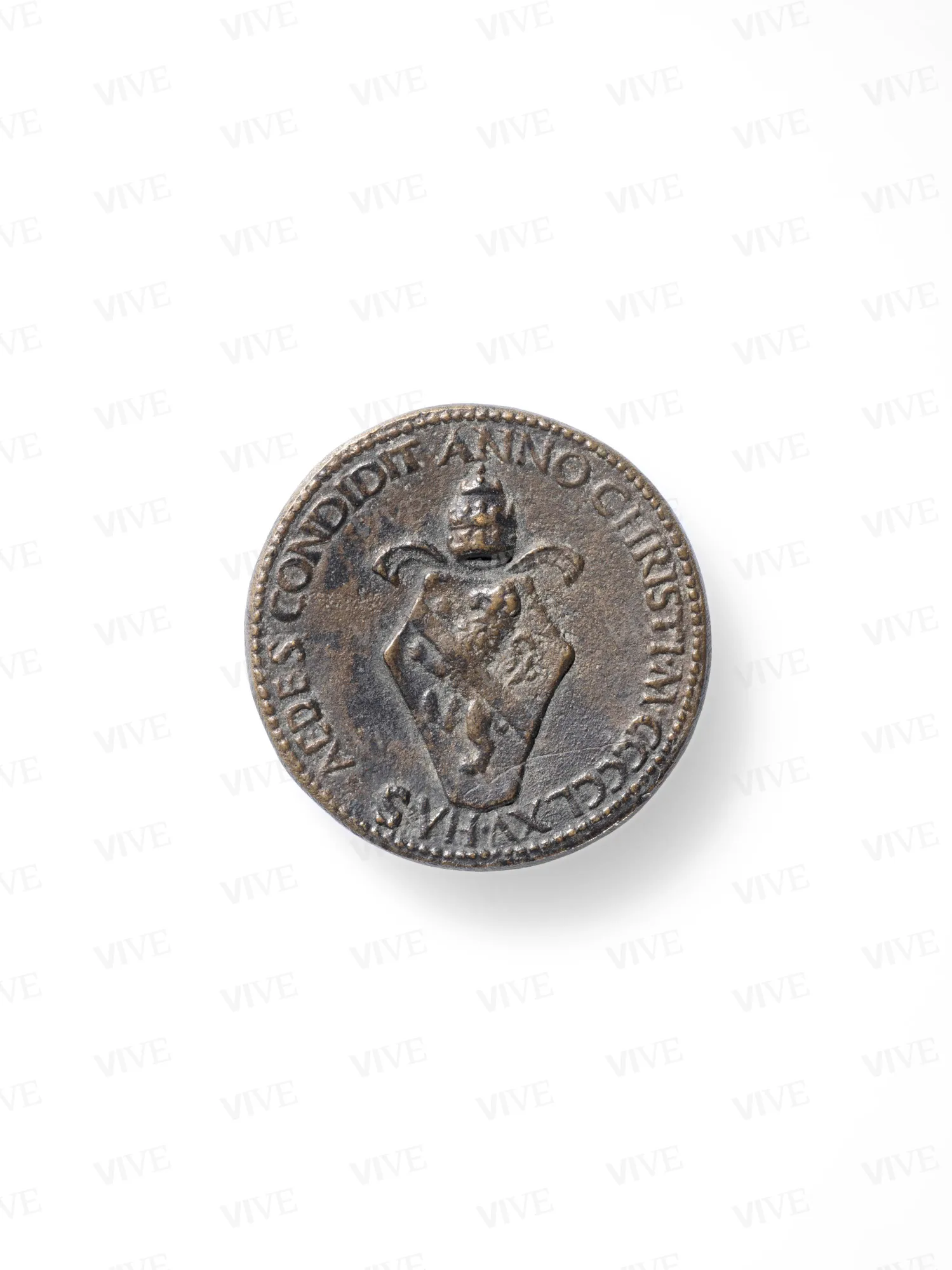Medal with Pope Paul II / Barbo coat of arms
Antonello Grifo called Della Moneta 1465
A medal depicting Pope Paul II was discovered inside a terracotta money box during the excavation of the foundations of Palazzo Venezia. This medal is dated 1465, coinciding with Barbo's ascension to the papacy and the initiation of construction on the building. The reverse side of the medal features the pope’s coat of arms, which includes a lion rampant and a diagonal band within a simple bucranium shield, crowned by the papal tiara adorned with unfurling infules. This emblem can be observed, either as frescoes or sculptures, in numerous rooms within Palazzo Venezia.
A medal depicting Pope Paul II was discovered inside a terracotta money box during the excavation of the foundations of Palazzo Venezia. This medal is dated 1465, coinciding with Barbo's ascension to the papacy and the initiation of construction on the building. The reverse side of the medal features the pope’s coat of arms, which includes a lion rampant and a diagonal band within a simple bucranium shield, crowned by the papal tiara adorned with unfurling infules. This emblem can be observed, either as frescoes or sculptures, in numerous rooms within Palazzo Venezia.
Details of work
Catalog entry
The obverse of the medal features a depiction of the pontiff's bust facing left, adorned with a tonsure and a cope embellished with plant motifs along the edge, secured at the chest by an oval gemmed button. On the reverse side, within an inscription indicating the date 1465, is the coat of arms of Pope Paul II (1417–1471, in office from 1464). The coat of arms includes a lion rampant facing left, crossed by an oblique band, and crowned with a tiara (Hill 1930, I, p. 204, n. 782).
Similar to many other medals featuring the visage of Barbo, this one was also used as a foundation object during the extension work on Palazzo Venezia. The newly elected pontiff commissioned the enlargement of the building, and it was discovered within one of the terracotta money boxes placed in the walls (Lanciani 1902, ed. 1989, pp. 68–69 and Weiss 1958, p. 76).
This medal type is available in several variants, which feature minor alterations in the legend. For instance, the obverse may bear the inscription “HANC ARCEM CONDIDIT” (see Modesti 2002, pp. 233–234, n. 79) or “PAPA” (see Modesti 2002, pp. 237–238, n. 81). Additionally, some variants include a thick molded border, emulating ancient Roman medallions. Notably, an example of this type was discovered during the restoration of Palazzo Venezia in 1926 (Balbi De Caro 1973, p. 26, fig. 28, measuring 53.7 mm; Modesti 2002, pp. 241–242, n. 83).
The coat of arms on the reverse is the one that Paul II adopted after his election as pope. It can be found in various parts of the Palazzo Venezia, both in fresco form, such as on the pilasters of the frieze with the labors of Hercules in the room where the sacred vestments were kept, and in sculpted versions above the portals of the pope’s apartment. Sometimes the coat of arms appears as an ancient French shield, other times as a simple bucranium, similar to the one visible on the reverse of this medal.
The significance of Pope Barbo’s coat of arms in defining the rooms of the palace and its importance to the pontiff is clearly demonstrated by the discovery of lead tiles. These tiles, which covered the main nave of the Basilica of San Marco—a part of the complex—bear the coat of arms along with the crossed keys and the tiara adorned with flowing infules (Weiss 1958, pp. 39–40; Cannata 1982, pp. 32–35, nn. 2–3).
The medal’s style suggests it was engraved by Antonello Grifo, known as Della Moneta, who worked in Venice and likely in Rome with the Venetian Barbo and Officine di San Marco.
Antonello Grifo was a coining engraver from the Marches who produced medals for Doge Francesco Foscari and worked at the Serenissima mint. Throughout his extensive career as an engraver and medal maker, it is likely that he spent some time in Rome with Pope Barbo, who had Venetian origins, and at the Officine di San Marco in Palazzo Venezia. Some stylistic features of his signed works can be recognized from this period (Zaccariotto 2018, pp. 47–48).
Giulia Zaccariotto
State of conservation
Good.
Inscriptions
Obverse: [within the border, within a panelled border] “PAVLVS • II VENETVS • PONT[ifex] • MAX[imus]”;
Reverse: [within the border, within a panelled border] “HAS • AEDES • CONDIDIT ANNO CHRISTI • M • CCCLXV •”
Provenance
Palazzo Venezia, foundation money boxes.
Exhibition history
Rome, Museo Nazionale di Palazzo Venezia, February–April, Rilievi e placchette dal XV al XVIII secolo, Rome 1982.
References
Hill George Francis, The Medals of Paul II, in «Numismatic Chronicle», s. 4, X, 1910, pp. 340-369;
Hill George Francis, A Corpus of Italian Medals of the Renaissance before Cellini, 2 voll., London 1930;
Weiss Roberto, Un umanista veneziano. Papa Paolo II, Venezia 1958;
Balbi De Caro Silvana, Le medaglie del Museo del Palazzo di Venezia in Roma, in «Medaglia», I, 1971, 2, pp. 7-15;
Balbi De Caro Silvana, Di alcune medaglie di Paolo II rinvenute nelle mura del Palazzo di Venezia in Roma, in «Medaglia», III, 1973, 5, pp. 24-34;
Cannata Pietro (a cura di), Rilievi e placchette dal XV al XVIII secolo, catalogo della mostra (Roma, Museo Nazionale di Palazzo Venezia, febbraio aprile 1982), Roma 1982;
Lanciani Rodolfo, Storia degli scavi di Roma e notizie intorno le collezioni romane di antichità (1000-1530), Roma 1989;
Modesti Adolfo, Corpus numismatum omnium Romanorum Pontificum. I. Da San Pietro (42-67) a Adriano VI (1522-1523), Roma 2002;
Modigliani Anna, Paolo II, papa, ad vocem, in Dizionario Biografico degli Italiani, LXXXI, Roma 2014;
Zaccariotto Giulia, Caratteri alfabetici e firme nelle medaglie italiane tra XV e XVI secolo, in Savio Adriano, Cavagna Alessandro (a cura di), Saggi di medaglistica, Collana di numismatica e scienze affini, Milano 2018, pp. 37-70.














